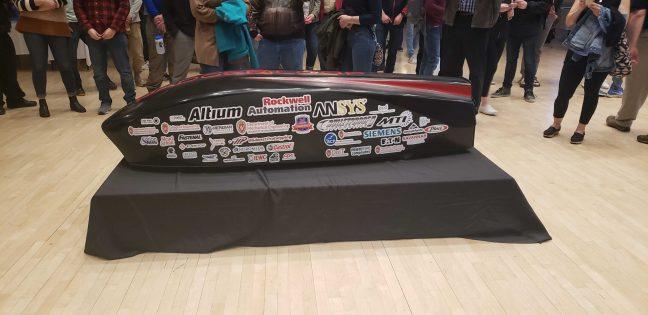Earlier this month, University of Wisconsin student organization Badgerloop revealed their newest hyperloop pod prototype — a sleek black vehicle they hope will launch them into the finals of SpaceX’s hyperloop pod competition.
For the past few years, Badgerloop has worked to create futuristic hyperloop pods — small, one-manned vehicles — to send to the SpaceX competition. Last year they narrowly missed the cutoff to make it to finals, but this year, as president Mark Swartz said at the reveal, they hope to claim a top-three spot — and the opportunity to send their pod down SpaceX’s vacuum-sealed hyperloop tube in California.
“I believe this group we have this year is special, and I’m continually impressed,” Swartz said.
But the journey to the finals won’t be easy. Even though the team revealed their pod, they still have tests and modifications to go through in order to improve, and eventually finalize, their prototype.
Sophomore and applied math, engineering and physics major Helena Van Hemmen is Badgerloops’s structural lead — she directs the team that designs the exterior of the pod. Van Hemmen described some of the challenges the team has faced and will continue to face before the competition in July. One major challenge she noted was organizing such a large team.
“We are a really big team, and we actually don’t have any sort of application process to be on the team,” Van Hemmen said. “That sort of sets us apart from a lot other hyperloop teams in the competition, and some other organizations on campus — that anyone can join — we’re just looking for people with enthusiasm for the project. That can make managing things sort of difficult actually.”
But Van Hemmen said the scale of the team and the absence of an application process also helps bring students with a wide variety of skills and interests together. She said while most students on the team study engineering, they also have members studying everything from communications to biology and sociology.
Van Hemmen said the team’s variety of experience levels also complicated things, though it can enhance the experience of being a part of the organization.
“We have seniors who join the team who have years of design experience, but we also have freshmen with no experience at all, and we try to make it as available to everyone as possible,” Van Hemmen said. “One of our major goals as an organization is to create an unparalleled learning experience for students on campus, and that’s not engineering students, that’s students from all backgrounds.”
Structural team member Zach Kimball worked with Van Hemmen on the exterior of the pod. He’s been on the team for two years, since joining as a sophomore.
Kimball recounted his experience joining the team originally. He said while the project felt daunting at first, he’s extremely glad he stuck with it.
“The first three weeks I was pretty nervous about joining the team, and I almost wanted to back out, just because we do so much in such a short time,” Kimball said. “Once I really got into the project, and once I really developed a passion for what I was doing, it just kinda seemed like a fun project to work on.”
Kimball said the hands-on experience was unlike anything he’d done in the classroom. He said while classes might teach him useful information to bring back to the project, there are some things he could only learn doing hands-on work through an organization like Badgerloop.
Badgerloop mechanical director Mitch Wall spoke to the gathered crowd both about some of the mechanics of the pod and what it meant to put everything together. Like Kimball, he said the organization succeeds because of the knowledge they gain outside of the classroom.
“One of the reasons me and my teammates get so excited about this team is that we get to solve problems nobody’s ever really tried to solve before,” Wall said. “As far as I know, there’s not really textbooks for how to build a hyperloop, so we just kind of make it up along the way.”
Wall said the team works with UW professors as well as industry experts to perfect the designs and technologies that go into the pod, from its carbon fiber exterior to its engine and braking systems.
Wall said he believes this year could be their best yet, with all the work they’ve put into the pod so far beginning to culminate.
“We’re all very proud of this pod and how far we’ve come,” Wall said.


